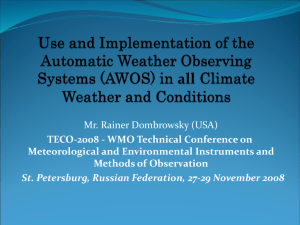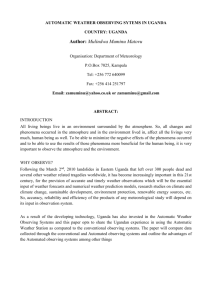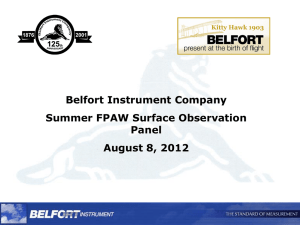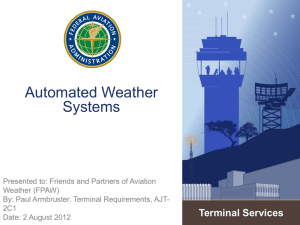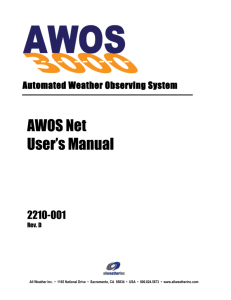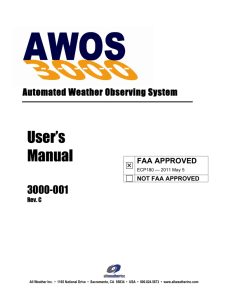USE AND IMPLEMENTATION OF THE AUTOMATIC WEATHER
advertisement
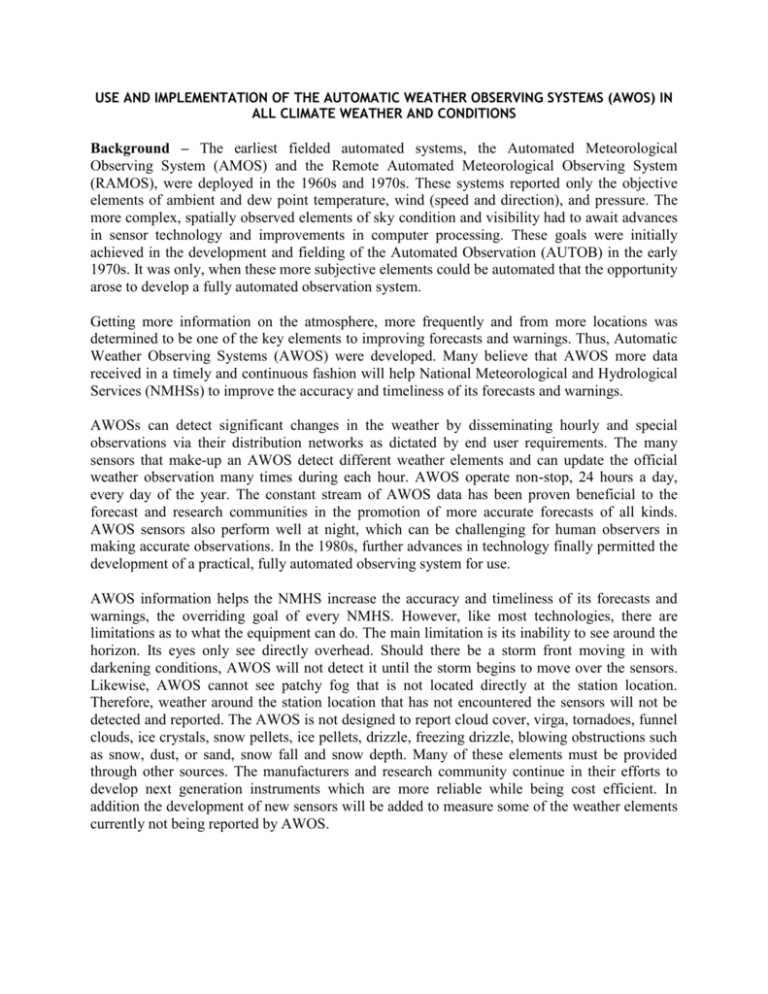
USE AND IMPLEMENTATION OF THE AUTOMATIC WEATHER OBSERVING SYSTEMS (AWOS) IN ALL CLIMATE WEATHER AND CONDITIONS Background – The earliest fielded automated systems, the Automated Meteorological Observing System (AMOS) and the Remote Automated Meteorological Observing System (RAMOS), were deployed in the 1960s and 1970s. These systems reported only the objective elements of ambient and dew point temperature, wind (speed and direction), and pressure. The more complex, spatially observed elements of sky condition and visibility had to await advances in sensor technology and improvements in computer processing. These goals were initially achieved in the development and fielding of the Automated Observation (AUTOB) in the early 1970s. It was only, when these more subjective elements could be automated that the opportunity arose to develop a fully automated observation system. Getting more information on the atmosphere, more frequently and from more locations was determined to be one of the key elements to improving forecasts and warnings. Thus, Automatic Weather Observing Systems (AWOS) were developed. Many believe that AWOS more data received in a timely and continuous fashion will help National Meteorological and Hydrological Services (NMHSs) to improve the accuracy and timeliness of its forecasts and warnings. AWOSs can detect significant changes in the weather by disseminating hourly and special observations via their distribution networks as dictated by end user requirements. The many sensors that make-up an AWOS detect different weather elements and can update the official weather observation many times during each hour. AWOS operate non-stop, 24 hours a day, every day of the year. The constant stream of AWOS data has been proven beneficial to the forecast and research communities in the promotion of more accurate forecasts of all kinds. AWOS sensors also perform well at night, which can be challenging for human observers in making accurate observations. In the 1980s, further advances in technology finally permitted the development of a practical, fully automated observing system for use. AWOS information helps the NMHS increase the accuracy and timeliness of its forecasts and warnings, the overriding goal of every NMHS. However, like most technologies, there are limitations as to what the equipment can do. The main limitation is its inability to see around the horizon. Its eyes only see directly overhead. Should there be a storm front moving in with darkening conditions, AWOS will not detect it until the storm begins to move over the sensors. Likewise, AWOS cannot see patchy fog that is not located directly at the station location. Therefore, weather around the station location that has not encountered the sensors will not be detected and reported. The AWOS is not designed to report cloud cover, virga, tornadoes, funnel clouds, ice crystals, snow pellets, ice pellets, drizzle, freezing drizzle, blowing obstructions such as snow, dust, or sand, snow fall and snow depth. Many of these elements must be provided through other sources. The manufacturers and research community continue in their efforts to develop next generation instruments which are more reliable while being cost efficient. In addition the development of new sensors will be added to measure some of the weather elements currently not being reported by AWOS. Purpose - Automatic weather stations are used for increasing the number and reliability of surface observations. They do this by: • • • • • • • • Increasing the density of an existing network by providing data from new sites and from sites which are difficult to access and are inhospitable; Supplying, for manned stations, data outside the normal working hours; Increasing the reliability of the measurements by using sophisticated technology and modern, digital measurement techniques; Ensuring homogeneity of networks by standardizing the measuring techniques; Satisfying new observational needs and requirements; Reducing human errors; Lowering operational costs by reducing the number of observers; Measuring and reporting with high frequency or continuously. Implementation – Once you have selected your AWOS platform which comes closest to meeting your requirements and the requirements of your end users, you will need to site your system at the most appropriate location to satisfy service requirements for data and information preparation. Sensors should be sited in accordance with guidance as published in the WMO Guide No. 8 which provides the standards for siting meteorological sensors. This information can also be attained through IOM 87 (TD 1307), “Training Material on Automated Observing Systems”. Siting - Determining the best locations to install AWOSs is the first and the most important step for over-all success in establishing an AWOS network. These locations should be determined by Guidelines provided by the WMO and other recognized standards organizations. During this process the following should be considered: • • • • • • • types of meteorological parameters to be measured; requirement for obtaining identified parameters; variability of parameters surrounding the station; size of the area represented by the station; suitability of the site for conducting meteorological observations; infrastructure and communication facilities, and documentation of all relevant metadata. Benefits An AWOS network is capable of: • • • • • • collecting, processing and displaying meteorological data; performing automated generation and transmission of meteorological reports; being configured to support a wide range of sensor configurations; supporting a number of data communication options; managing all communication protocols for the various sensors and other associated data communication equipment; storing all relevant data for immediate or future retrieval as required; • • • allowing manual input of additional information unable of being automatically measured; providing the first level of quality control on both data measurement and message generation, and allowing authorized users to access data remotely; Advantages of an automated weather observing systems - As expected, automated observations systems have many advantages over manual systems. These advantages are summarized as follows: • • • • • • • • • • • • • • • • Standardization of network observations, both in time and quality; Real-time continuous measuring of parameters on a 24/7 basis; Great accuracy; Generally more reliable; More reliable; Conducts automatic data archiving; Provides higher data resolution; Collection of data in a greater volume; Adjustable sampling interval for different parameters; Generally free of reading errors; Generally free from subjectivity; Automatic QC applied during collection and reporting stages; Automatic message generation and transmission; Monitoring of meteorological data: Access to archived data locally or remotely, and Data collection in harsh climates. Disadvantages of automated observations – Some of the disadvantages of automated observations are as follows: • • • • • • • Limited area representation, an area of about 3-5 km around the sensor site; It is not possible to observe all parameters automatically as are done through a manual approach toward taking an observation or an approach whereby the automatic observation is augmented by a human observer, for example cloud coverage and cloud types; Ongoing periodic routine maintenance; Periodic testing and calibration; Insure that a staff of well trained technicians and specialists is maintained; Insure that a well trained staff of operators is maintained, and Resulting higher cost of instrumentation and operation. However, the more efficiencies gained through greater levels of automation may result in some cost benefits. Maintenance - The most important process after the installation of an AWOS network is the implementation of a routine maintenance process including the system and each sub component. An effective maintenance process requires three distinct levels of maintenance as listed below: Protective maintenance - is an equipment maintenance strategy based on replacing or overhauling an item at a fixed interval, regardless of its condition at the time. Preventive Maintenance has to be distinguished from corrective maintenance or condition based maintenance, the process of performing regularly scheduled maintenance tasks. Routine maintenance can often be performed without locking out a machine. Corrective maintenance - is any maintenance activity which is required to correct a failure that has occurred or is in the process of occurring. This activity may consist of repair, restoration or replacement of components. Corrective maintenance has to be distinguished from preventative maintenance or condition based maintenance. Calibration - The process of determining the performance parameters of an, instrument, or system by comparing it with measurement standards. Adjustment may be a part of a calibration, but not necessarily. A calibration assures that a device or system will produce results which meet or exceed some defined criteria with a specified degree of confidence. Two important measurement concepts related to calibration are precision and accuracy. Precision refers to the minimum discernible change in the parameter being measured, while accuracy refers to the actual amount of error that exists in a calibration. It must be understood that all measurement processes used for calibration are subject to various sources of error. It is common practice to classify them as random or systematic errors. When a measurement is repeated many times, the results will exhibit random statistical fluctuations which may or may not be significant. Systematic errors are offsets from the true value of a parameter and, if they are known, corrections are generally applied, eliminating their effect on the calibration. If they are not known, they can have an adverse effect on the accuracy of the calibration. High-accuracy calibrations are usually accompanied by an analysis of the sources of error and a statement of the uncertainty of the calibration. Uncertainty indicates how much the accuracy of a calibration could be degraded as a result of the combined errors. Metadata - Users of meteorological observations often need to know the actual exposure, type and condition of the equipment and its operation; and perhaps the methods employed in the taking of the observations. This is now particularly significant in the study of climate, in which detailed station histories have to be examined. Metadata (data about data) should be kept concerning all the station establishment and maintenance activities and concerning changes which occur, including calibration and maintenance history, as well as, changes in exposure and staff if the AWOS is augmented. Metadata are especially important for the elements that are particularly sensitive to exposure, such as precipitation, wind and temperature. One very basic form of metadata is information on the existence, availability and quality of meteorological data and of the metadata related to them. Measurements taken in harsh climates: Most instruments are designed for use in moderate climate zones, although requirements are intended to be valid for all climate zones. The Expert Team on Surface Technology and Measurement Techniques (ET-ST&MT) reported that special attention needed to be give to system operations in harsh environments such a the Arctic, Tropics, Deserts and Mountainious regions as well a climates suseptible to severe weather events. The expert team noted the lack of standardization practices for measurements in harsh climates. It recognized that instrument performance suitable for such harsh cold environments is often attributable to instrument design and not related to the icing condition. At this time only limited guidance material is available on the implementation and maintenance of automatic observing systems which reside in harsh climates. CIMO in cooperation with its partners needs to examine not only the performance and maintenance issues of systems in harsh climates but also the issues related to instrument failure due to the effects of corrosion resulting from extreme weather conditions. In their report to CIMO the ET identified actions necessary to address these issues: • • • • Expansion of the definitions and requirements on measurements in severe/harsh weather conditions. To develop and provide requirements for instrument development addressing the issues related to instrument operation in harsh climates. Encourage instrument manufacturers to develop hardened instruments to meet the challenges related to measurements conducted in harsh climate conditions. Once new instruments are developed organize further evaluation through the intercomparison process. Conclusions: • • • • • • • Automation of observing systems is being adopted by many more NMHSs with the intent of providing for better meteorological services. An automated weather observing network should be designed with careful attention to user requirements and siting criteria. Products and services expected from AWOS network should be defined very clearly and should reflect user needs. The proposed network should be flexible enough to absorb new hardware and software components as technology changes. Site selection should be done by following the WMO recommendations, but infrastructure needs must also be adequately addressed, such as power requirements, grounding, lightning protection, access to the station, as well as considering communication options. Operators and technicians should be trained to operate and maintain the network efficiently. As sensors change and the network is modified in some fashion the training of these individuals should be given well before the changes are implemented. The need to create and maintain a through history of the site and instrument/system • Do not ignore the need for maintaining a sufficient funding allocation to address the long-term life cycle of the systems.
